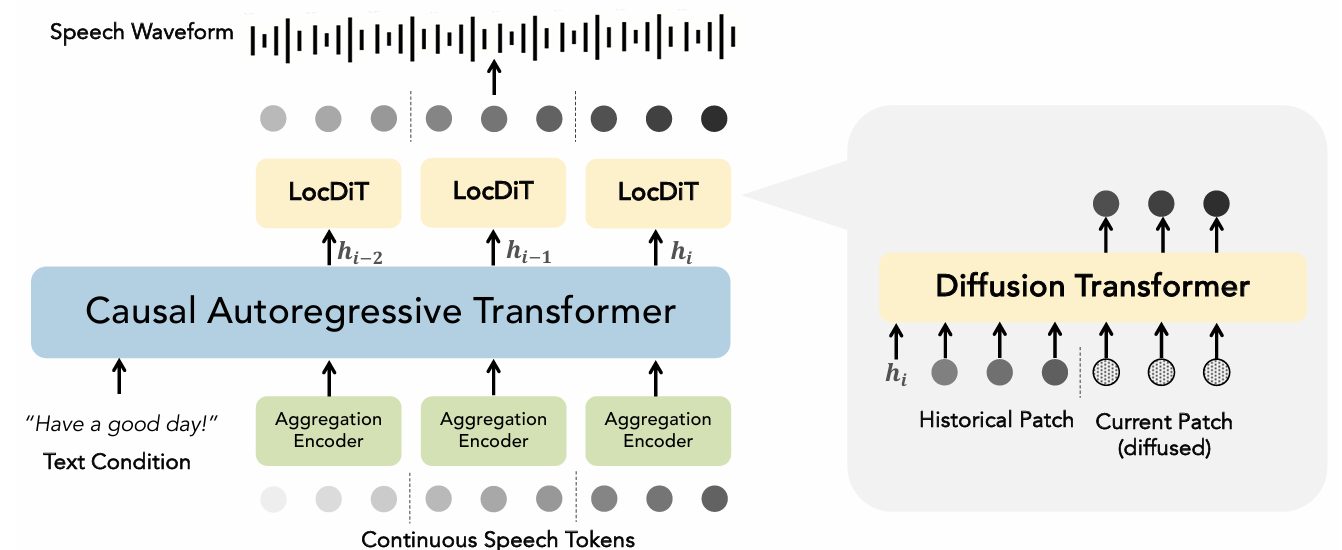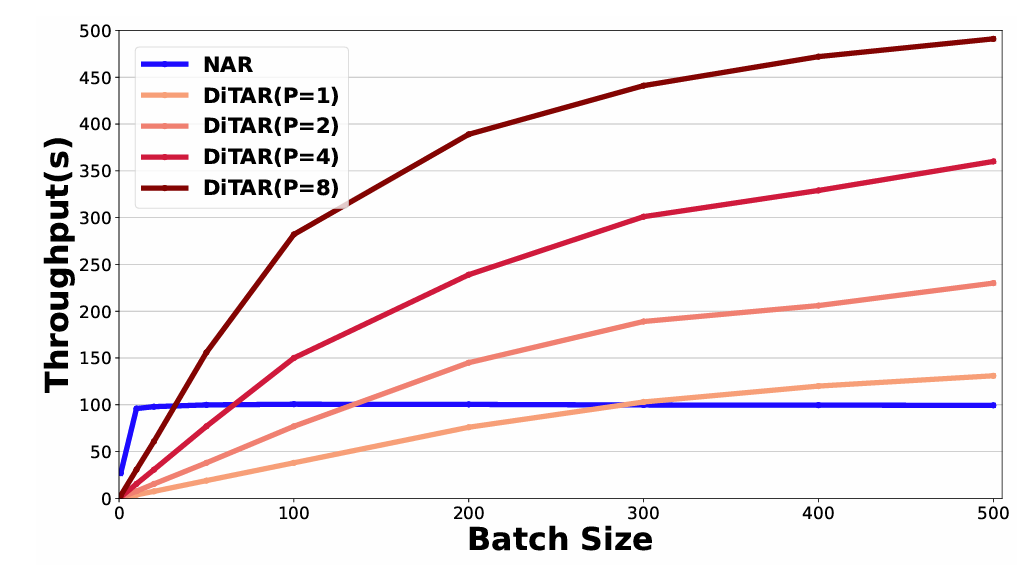티스토리 뷰
Paper/Language Model
[Paper 리뷰] DiTAR: Diffusion Transformer Autoregressive Modeling for Speech Generation
feVeRin 2025. 6. 29. 09:05반응형
DiTAR: Diffusion Transformer Autoregressive Modeling for Speech Generation
- Diffusion model과 autoregressive model을 결합하면 computational load와 suboptimal outcome이 발생함
- DiTAR
- Patch generation을 위해 divide-and-conquer strategy를 도입
- Langauge model은 aggregated patch embedding을 처리한 다음, diffusion Transformer를 통해 next patch를 subsequently generate
- 추론 시에는 reverse diffusion ODE 중 noise introducing time point를 temperature로 정의하여 diversity와 determinism을 balancing
- 논문 (ICML 2025) : Paper Link
1. Introduction
- Autoregressive Speech Language Model (LM)에서 discrete tokenization은 bitrate limitation으로 인해 complex modality를 high-fidelity로 reconstruct 하는데 한계가 있음
- 특히 zero-shot Text-to-Speech (TTS)에서 CosyVoice와 같은 기존 방식은 coarse-to-fine pipeline을 가짐
- BUT, 해당 cascaded design은 error accumulation으로 인해 LM의 scalability를 저해함 - 한편으로 LM으로 lossy discrete token을 먼저 생성한 다음, detail enrichment를 위한 token-based diffusion을 적용할 수도 있음
- BUT, diffusion model은 continuous representation modeling에 효과적이지만 상당한 computational demand를 요구함
- 이때 LM이 final feature를 directly predict 하면 process를 simplify 할 수 있음
- 특히 zero-shot Text-to-Speech (TTS)에서 CosyVoice와 같은 기존 방식은 coarse-to-fine pipeline을 가짐
-> 그래서 Transformer diffusion과 language model을 seamlessly combine 한 DiTAR를 제안
- DiTAR
- Continuous token을 multiple patch로 break하는 divide-and-conquer strategy를 도입
- 이때 LM은 inter-patch prediction을 수행하고 diffusion Transformer는 intra-patch prediction을 수행함 - 추가적으로 Bidirectional attention 기반의 Diffusion Transformer (DiT)로 구성된 LocDiT를 통해 localized patch를 predict하고 LocDiT의 generative capability를 향상하기 위해 LM guidance를 적용
- 추론 시에는 temperature-based sampling을 통해 diversity, determinism을 adeptly balance
- Continuous token을 multiple patch로 break하는 divide-and-conquer strategy를 도입
< Overall of DiTAR >
- Divide-and-conquer patchification과 DiT를 활용한 zero-shot TTS language model
- 결과적으로 기존보다 뛰어난 성능을 달성
2. Method
- DiTAR는 continuous representation에 기반한 patch-based autoregressive model로써 causal-attention AR과 bidirectional-attention Transformer diffusion을 활용함
- Overview
- Formulation
- DiTAR는 next-token prediction을 활용하는 autoregressive model에 해당함
- 먼저 continuous token sequence $x=(x_{1},x_{2},...,x_{N})$에 대해 chain rule을 사용하여 sequence의 joint distribution을 factorize 할 수 있음:
(Eq. 1) $p_{\theta}(x_{1},x_{2},...,x_{N})=\prod_{i=1}^{N}p_{\theta}(x_{i}|x_{1},x_{2},...,x_{i-1})$
- $\theta$ : AR generative model의 parameter - 여기서 adjacent continuous token 간의 high similarity를 고려하면 local region 내에서 bidirectional dependency가 존재한다고 볼 수 있음
- 이를 기반으로 논문은 local $x_{i}$를 size $P$의 patch로 aggregate 하고 각 patch 내의 token을 modeling 하기 위해 bidirectional attention을 도입함 - 그러면 model은 $\theta_{a}, \theta_{b}$의 두 가지 part로 나눌 수 있음:
- $\theta_{a}$는 $p_{\theta_{a}}(h_{i}|x_{1},x_{2},...,x_{i})$를 통해 long context learning을 담당하는 autoregressive model을 의미함
- $\theta_{b}$는 $p_{\theta_{b}}(x_{i+1},...,x_{i+P}|h_{i})$를 통해 next patch prediction을 수행하는 bidirectional attention diffusion Transformer를 의미함
- $h_{i}$ : language model output으로써 diffusion condition에 해당함
- Zero-shot TTS를 AR model에 대한 conditional continuation task로 취급하면 DiTAR를 활용할 수 있음
- 즉, target text, prompting speech를 concatenate 하여 prefix context로 model에 전달하면 주어진 context에 따라 target speech를 autoregressively generate 할 수 있음
- Overall Architecture
- Causal-attention autoregressive model을 diffusion loss와 combine 하면 full attention에 비해 성능이 저하됨
- 이를 해결하기 위해 논문은 continuous token의 long sequence를 multiple patch로 divide 하는 divide-and-conquer strategy를 도입함
- 여기서 language model은 inter-patch prediction을 수행하고 diffusion Transformer는 intra-patch prediction을 수행함
- 특히 DiTAR의 backbone은 next-token prediction을 위한 causal attention Transformer로 구성되므로 continuous token의 각 patch는 aggregate encoder를 사용하여 single vector로 process 됨
- 그런 다음 AR model에 전달되어 output embedding $h_{t}$를 생성하고, $h_{t}$는 diffusion decoder인 LocDiT의 condition으로 사용됨 - 추가적으로 논문은 training 시 output continuous token에 대한 diffusion loss를 사용함

- LocDiT: Next-Patch Bidirectional Modeling
- Diffusion Transformer (DiT)는 bidirectional Transformer의 full receptive field를 활용하여 entire sample을 생성함
- 특히 논문은 Local Diffusion Transformer (LocDiT)를 사용하여 localized continuous token patch를 생성함
- 이때 DiT의 context learning potential을 capitalize 하기 위해 context-aware diffusion approach를 도입함
- 이를 위해 token의 historical patch를 LocDiT의 prefix input으로 사용해 task를 outpainting과 closely aligning 하여 generation 성능을 크게 향상함 - 한편으로 CosyVoice와 같은 기존 방식은 coarse, fine feature를 explicitly delineate 함
- BUT, 해당 multi-stage method는 cumulative error에 prone 함
- 따라서 DiTAR는 각 patch의 token을 implicit lower-dimensional feature space로 condense 한 다음, LocDiT를 통해 high-fidelity continuous token으로 subsequently expand 하여 end-to-end manner로 동작함
- LM Guidance
- Classifier-Free Guidance (CFG)는 generative model의 condition adherence를 개선하기 위해 사용됨
- Diffusion에서 unconditional, conditional model은 parameter를 share 하고 training 중에 condition을 intermittently omit 하여 jointly training 됨
- 추론 시 두 model output은 diversity, fidelity 간의 trade-off를 위해 parameter $w$로 merge 됨
- 이는 distribution 하에서 sampling 하는 것과 equivalent 함
- $\theta$ : model parameter, $c$ : condition, $z_{t}$ : time $t$의 noisy sample
- Continuous-token LM에서는 주로 diffusion head에 class label을 incorporate 하고 CFG를 적용하지만, 해당 방식은 generality가 부족함
- 따라서 DiTAR에서는 모든 condition을 LM prefix input 내에 place 하고 CFG를 diffusion decoder에서 AR의 on-the-fly output으로 적용함
- 여기서 AR의 $i$-th output $h_{i}$는 all historical input $(x_{0},x_{1},...,x_{i})$를 represent 함 - Training 시에는 $h_{i}$를 null embedding으로 randomly replace 하고, 추론 시에는 distribution $p_{\theta}(z_{i,t}|x_{1},...,x_{i-1})p_{\theta}(x_{1},...,x_{i-1}|z_{i,t})^{w}$에서 sampling 함:
(Eq. 2) $ \tilde{\epsilon}_{\theta}(z_{i,t},h_{i})=(1+w)\epsilon_{\theta}(z_{i,t},h_{i})-w \epsilon_{\theta}(z_{i,t})$
- $z_{i,t}$ : diffusion time $t$에서 sequence의 $i$-th noisy sample, $\epsilon_{\theta}$ : LocDiT로 estimate 된 score
- 따라서 DiTAR에서는 모든 condition을 LM prefix input 내에 place 하고 CFG를 diffusion decoder에서 AR의 on-the-fly output으로 적용함
- Diffusion에서 unconditional, conditional model은 parameter를 share 하고 training 중에 condition을 intermittently omit 하여 jointly training 됨
- Temperature for Continuous-Valued LMs
- Discrete-valued LM에 비해 Continuous-valued LM에서 temperature-based sampling은 잘 활용되지 않음
- 따라서 논문은 ODE solver와 compatible 한 temperature 정의를 가진 sampling method를 구성함
- Temperature $\tau \in[0,1]$을 diffusion의 reverse ODE solving에서 noise를 introduce 하는 time point로 정의하자
- Per-patch의 Gaussian diffusion forward process가 $x_{t}=\alpha_{t}x_{0}+\sigma_{t}\epsilon$로 주어지면, $\alpha_{t}, \sigma_{t}$는 flow path를 collectively define 함
- $x_{0}\sim q_{data}(x_{0}),\epsilon \sim\mathcal{N}(0,I),t\in [0,1]$ - $\tau=1$에서 sampling process는 standard ODE sampling process와 equivalent 하고, 이때 논문은 $dt$에 대해 $1$에서 $0$까지 reverse ODE $dx_{t}=v_{\theta}(x_{t},t)dt$를 solve 함
- $x_{1}\sim\mathcal{N}(0,I)$ - $\tau=0$에서는 random noise가 introduce 되지 않으므로 completely deterministic process가 됨
- $0$은 standard Gaussian distribution에서 highest likelihood를 가지는 value이므로, 논문은 $x_{1}\equiv 0$의 sampling을 greedy sampling으로 정의하여 determinism을 보장함
- $0<\tau<1$인 경우, estimated $x_{0}$를 diffuse 하기 위해 forward process를 사용하여 $\tau$에 random noise를 introduce 함
- 이때 iterative process는:
(Eq. 3) $x_{1}\sim \left\{\begin{matrix}
\mathcal{N}(0,I), & \text{if}\,\,\tau=1 \\
0, & \text{if}\,\,0\leq \tau <1 \\
\end{matrix}\right.$
(Eq. 4) $x_{t}=\left\{\begin{matrix}
x_{t+\Delta t}-v_{\theta}(x_{t+\Delta t},t+\Delta t)\Delta t, & \text{if}\,\, t\neq \tau \\
\alpha_{t}x_{\theta}(x_{t+\Delta t},t+\Delta t)+\sigma_{t}\epsilon, & \text{if}\,\,t=\tau \\
\end{matrix}\right.$
- $x_{\theta}$ : estimated $x_{0}$
- 따라서 논문은 ODE solver와 compatible 한 temperature 정의를 가진 sampling method를 구성함

- Implementations
- Continuous Speech Tokenization
- 논문은 Variational AutoEncoder (VAE)를 사용하여 waveform을 latent $z$의 distribution으로 convert 함
- VAE encoder는 multiple layer의 convolutional network이고, decoder는 BigVGAN을 따름
- 추가적으로 Multi-Period Discriminator (MPD), Multi-Scale Discriminator (MSD)를 discriminator로 사용함 - 결과적으로 24000Hz waveform은 64 dimension의 40Hz latent로 compress 됨
- Model
- DiTAR는 Transformer 기반의 aggregator encoder, LM, decoder (LocDiT)로 구성됨
- Encoder, decoder는 bidirectional attention mask를 사용하고 LM은 causal attention mask를 사용함
- 모든 Transformer는 PreNorm architecture를 활용하고 RMSNorm, RoPE를 사용함
- Continuous token의 각 patch는 sequence beginning에 위치한 learnable special token과 함께 aggregation encoder에 전달됨
- 다음으로 special token position에 해당하는 output은 aggregation embedding으로 사용되고, 서로 다른 patch에서 생성되는 aggregation embedding은 LM에 대한 sequence를 구성함
- 이후 LM output과 time embedding이 add 되고 historical context patch, noisy target token과 함께 LocDiT input sequence를 구성함
- Loss calculation 시에는 noisy target token의 position에 해당하는 output 만을 고려함
- Training 시에는 LM output이 $0.1$의 probability로 all-zero vector로 randomly replace 되어 LocDiT에 대한 LM guidance를 지원함
- DiTAR는 Transformer 기반의 aggregator encoder, LM, decoder (LocDiT)로 구성됨
- Diffusion Formulation
- 논문은 variance-preserving diffusion process를 고려함:
(Eq. 5) $x_{t}=\alpha_{t}x_{0}+\sigma_{t}\epsilon$
(Eq. 6) $\,\,\,\,\,\,\,=\cos\left(\frac{\pi t}{2}\right)x_{0}+\sin\left(\frac{\pi t}{2}\right)\epsilon$
- $x_{0}\sim q(x_{0})$ : data, $\epsilon\sim\mathcal{N}(0,I)$ : standard Gaussian noise, $t\in [0,1]$ - 이때 Conditional Flow-Matching은:
(Eq. 7) $\mathcal{L}_{diff}=\mathbb{E}_{t,x_{0},\epsilon}\left[\left|\left| v_{\theta}(x_{t},t)-v(x_{t},t)\right|\right|_{2}^{2}\right]$
- Velocity는 $v(x_{t},t)=\dot{x}_{t}=\dot{\alpha}_{t}x_{t}+\dot{\sigma}_{t}\epsilon$과 같이 정의됨 - 추론 시에는 $t$이 아닌 signal-to-noise ratio $\frac{\alpha_{t}^{2}}{\sigma_{t}^{2}}$에 대한 Euler ODE sampler에 해당하는 DDIM sampler를 사용함
- 이는 diffusion ODE의 semi-linear property와 better align 됨
- 논문은 variance-preserving diffusion process를 고려함:
- Zero-Shot TTS System
- Text sequence는 phoneme으로 convert 된 다음 lookup table을 통해 text embedding을 얻고, speech token은 aggregation encoder를 통해 speech embedding을 생성한 다음 text embedding과 concatenate 됨
- 이후 embedding sequence는 LM에 대한 input으로 사용됨
- 추가적으로 LM output에 stop을 predict 하기 위한 fully-connected layer로 구성된 binary classifier를 적용함
- 결과적으로 zero-shot TTS에 대한 loss function은:
(Eq. 8) $\mathcal{L}=\mathcal{L}_{diff}+\mathcal{L}_{stop}$ - 추론 시에는 prompt audio, text, target text가 LM의 prefix input으로 제공되어 target audio를 autoregressively generate 함
- Text sequence는 phoneme으로 convert 된 다음 lookup table을 통해 text embedding을 얻고, speech token은 aggregation encoder를 통해 speech embedding을 생성한 다음 text embedding과 concatenate 됨
3. Experiments
- Settings
- Dataset : LibriLight, Emilia
- Comparisons : VALL-E, Mega-TTS2, NaturalSpeech2, NaturalSpeech3, VoiceBox, MaskGCT, E2-TTS, F5-TTS
- Results
- 전체적으로 DiTAR는 뛰어난 성능을 달성함

- MOS 측면에서도 우수한 성능을 보임

- Scaling Behaviors
- Training data, model parameter가 증가할수록 DiTAR의 성능도 향상됨

- Langauge model과 LocDiT를 enlarge 하는 것에 비해 encoder는 성능 향상에 큰 영향을 주지 않음

- Patch Size
- LocDiT의 patch size가 너무 크거나 작으면 성능이 저하됨

- LM Guidance
- LM guidance를 사용하면 diffusion decoder의 inference process를 개선할 수 있음

- Impact of Temperature
- Temperautre $\tau$가 증가할수록 speaker diversity도 증가함

- Efficiency
- Batch size가 증가하면 DiTAR의 throughput은 rapidly increase 하여 NAR 보다 더 나은 efficiency를 보임

반응형
'Paper > Language Model' 카테고리의 다른 글
댓글
